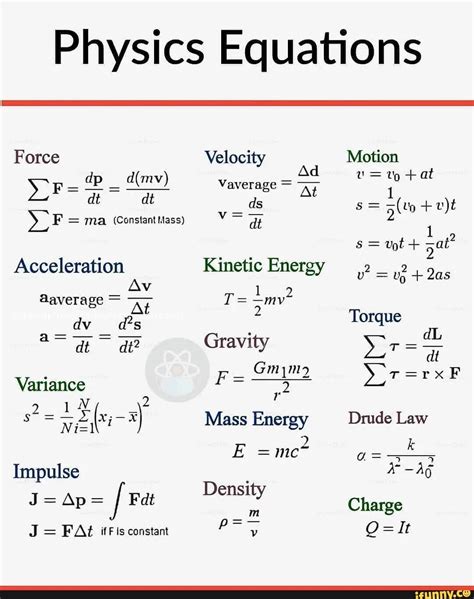In physics, M refers to mass, a fundamental property of matter that quantifies its resistance to acceleration. Mass is a scalar quantity, meaning it has only magnitude and no direction. The SI unit of mass is the kilogram (kg).

Measuring Mass
Mass can be measured using a variety of methods, including:
- Balance scale: This classic method compares the mass of an unknown object to a known mass by balancing them on a beam.
- Spring scale: This device measures the force required to stretch or compress a spring, which is proportional to the mass of the object attached to it.
- Electronic scale: This modern device uses strain gauges or other sensors to measure the weight of an object and convert it to mass.
Types of Mass
There are two main types of mass:
- Gravitational mass: This is the mass of an object as measured by its gravitational attraction to another object.
- Inertial mass: This is the mass of an object as measured by its resistance to acceleration.
According to the equivalence principle, gravitational mass and inertial mass are equivalent.
Mass and Energy
Mass and energy are interconvertible, according to Einstein’s famous equation E=mc². This means that a small amount of mass can be converted into a large amount of energy, and vice versa.
Importance of Mass
Mass is a fundamental property that plays a crucial role in various physical phenomena, including:
- Motion: Mass affects the motion of objects by determining their inertia, or resistance to change in motion.
- Gravity: Mass is the source of gravitational attraction, which governs the interactions between objects in the universe.
- Nuclear reactions: Mass is a key factor in nuclear reactions, where changes in mass release or absorb energy.
- Cosmic structure: The mass of stars, planets, and galaxies influences the formation and evolution of cosmic structures.
Applications of Mass
The concept of mass has numerous applications in science and technology, including:
- Engineering: Mass is considered in structural design to ensure stability and safety.
- Astronomy: Mass measurements help determine the properties of celestial objects, such as stars and galaxies.
- Medicine: Mass is used to calculate drug dosages and assess body composition.
- Manufacturing: Mass is controlled in precise manufacturing processes to ensure product quality and efficiency.
- Exploration: Mass is a factor in spacecraft design and fuel calculations.
Table 1: Comparison of Mass Measurement Methods
| Method | Advantages | Disadvantages |
|---|---|---|
| Balance scale | Simple and inexpensive | Less precise |
| Spring scale | Portable and easy to use | Can be affected by temperature |
| Electronic scale | Precise and digital | Can be expensive |
Table 2: Applications of Mass in Science and Technology
| Field | Application |
|---|---|
| Engineering | Structural design, material properties |
| Astronomy | Stellar masses, galaxy dynamics |
| Medicine | Drug dosage, body composition analysis |
| Manufacturing | Quality control, product efficiency |
| Exploration | Spacecraft design, fuel calculations |
Table 3: Mass and its Importance in Physical Phenomena
| Phenomena | Role of Mass |
|---|---|
| Motion | Inertia, resistance to acceleration |
| Gravity | Source of gravitational attraction |
| Nuclear reactions | Energy release or absorption |
| Cosmic structure | Formation and evolution of celestial objects |
Table 4: Conversion between Mass and Energy
| Formula | Relationship |
|---|---|
| E = mc² | Energy (E) is equal to mass (m) multiplied by the speed of light squared (c²) |
FAQs
Q: What is the difference between mass and weight?
A: Mass is the amount of matter in an object, while weight is the force exerted on an object due to gravity.
Q: Can mass change?
A: Mass can change in nuclear reactions, where mass is converted into energy or vice versa. However, in most everyday situations, mass is considered constant.
Q: What is the mass of an electron?
A: The mass of an electron is approximately 9.11 x 10^-31 kg.
Q: How is mass used to calculate density?
A: Density is defined as mass per unit volume. To calculate density, divide the mass of an object by its volume.
Q: How is mass related to buoyancy?
A: Buoyancy, or the upward force exerted on an object in a fluid, is directly related to the mass of the fluid displaced by the object.
Conclusion
Mass is a fundamental property of matter that plays a critical role in understanding and predicting physical phenomena. Its measurement and application have far-reaching implications in science, technology, and various aspects of our daily lives.
